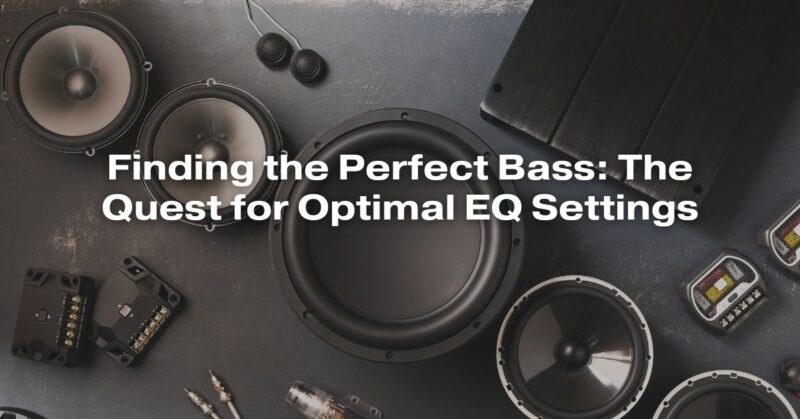Music is a universal language that transcends borders and cultures, and the bass guitar plays a crucial role in shaping the rhythm and groove of a song. Whether you’re a seasoned bassist or just starting your musical journey, achieving the perfect bass tone is a pursuit that can be both exciting and challenging. One of the key tools in your arsenal for shaping your bass tone is the EQ (equalization) settings. In this article, we’ll explore the art of finding the perfect bass tone through optimal EQ settings.
The Significance of Bass EQ
Equalization is the process of adjusting the balance between different frequency components in an audio signal. When it comes to bass, this means tweaking the EQ settings to emphasize or de-emphasize certain frequencies. Proper bass EQ is essential for several reasons:
1. Clarity and Definition:
Effective EQ settings can bring out the clarity and definition in your bass sound. They allow you to cut through the mix and ensure that your bass lines are heard distinctly, even in dense musical arrangements.
2. Tonal Character:
EQ settings can help you shape the tonal character of your bass. Whether you prefer a warm, round sound or a bright, punchy one, the EQ can help you achieve your desired tonal quality.
3. Mix Balance:
In a band or recording context, a well-EQ’d bass guitar ensures that it complements other instruments in the mix rather than overpowering them. It’s crucial for achieving a balanced and cohesive sound.
Understanding Bass Frequency Range
Before diving into EQ settings, it’s essential to understand the bass guitar’s frequency range. The fundamental frequency of a standard-tuned bass guitar is around 41 Hz (E1), but it can go much lower (sub-bass) and extend higher (upper harmonics). Here’s a general breakdown:
- Sub-Bass (20-60 Hz): These are the lowest, often felt more than heard. Subwoofers and powerful speakers are needed to reproduce these frequencies.
- Bass (60-250 Hz): This is the core of the bass guitar’s sound. It provides warmth and body to the tone.
- Low-Mids (250-500 Hz): This range affects the “growl” or “mud” in your bass tone. Adjusting these frequencies can improve clarity.
- Mids (500 Hz – 1 kHz): This range adds definition and can help your bass cut through the mix.
- Upper Mids (1-2 kHz): Enhancing this range can add presence and articulation to your bass lines.
- Highs (2 kHz and above): These frequencies provide brightness and attack to your tone.
Finding Your Perfect Bass Tone
Achieving the perfect bass tone is a subjective endeavor, as it depends on your musical style, personal preferences, and the context in which you’re playing. Here’s a step-by-step guide to help you find your optimal EQ settings:
1. Start Flat:
Begin with all your EQ knobs (bass, midrange, treble) set to their neutral or flat positions. This is often indicated as the 12 o’clock position on most amplifiers and pedals.
2. Experiment with the Bass Control:
Start by adjusting the bass control. If your bass sounds muddy, reduce the bass frequency (usually below 100 Hz). If it lacks warmth and body, increase it. Listen carefully and make subtle adjustments.
3. Tame the Low-Mids:
If your tone still sounds muddy or lacks clarity, consider reducing the low-mid frequencies (around 250-500 Hz). This can help reduce muddiness and make your bass lines more defined.
4. Define the Mids:
Depending on your playing style, you may want to enhance or cut the midrange frequencies. Boosting the mids (500 Hz – 1 kHz) can provide more presence and help your bass cut through the mix. Cutting the mids can create a scooped tone, often used in metal and funk music.
5. Add Upper-Mid Presence:
To give your bass more articulation and attack, consider boosting the upper-mid frequencies (1-2 kHz). This can make your bass lines more distinct and lively.
6. Shape the Highs:
Adjust the treble control to add brightness and attack to your tone. Be cautious not to overdo it, as excessive treble can lead to harshness or unwanted noise.
7. Listen and Adjust:
Throughout this process, listen closely to how each adjustment affects your tone. Play different bass lines and pay attention to how your bass interacts with other instruments in the mix. Make incremental changes and trust your ears.
8. Consider Your Gear:
Remember that your bass guitar, amplifier, and pedals all contribute to your overall tone. Experiment with different combinations to find what works best for you.
9. Record and A/B Test:
If you’re recording, make sure to record your bass tone as you adjust the EQ settings. This allows you to A/B test different settings and choose the one that works best for your song or project.
10. Seek Feedback:
Don’t be afraid to seek feedback from fellow musicians or producers. Sometimes, a fresh set of ears can provide valuable insights.
Conclusion
Finding the perfect bass tone through optimal EQ settings is a journey that requires patience and experimentation. There is no one-size-fits-all solution, as your ideal tone depends on your musical style and personal preferences. The key is to understand the frequency range of your bass guitar, start with a neutral EQ, and make gradual adjustments while listening attentively. Trust your ears, and don’t be afraid to seek feedback from others. With time and practice, you’ll discover your unique bass sound that enhances your music and brings it to life. Remember, the quest for the perfect bass tone is a rewarding adventure in itself, and it’s one that can lead to endless sonic possibilities in your musical journey.

